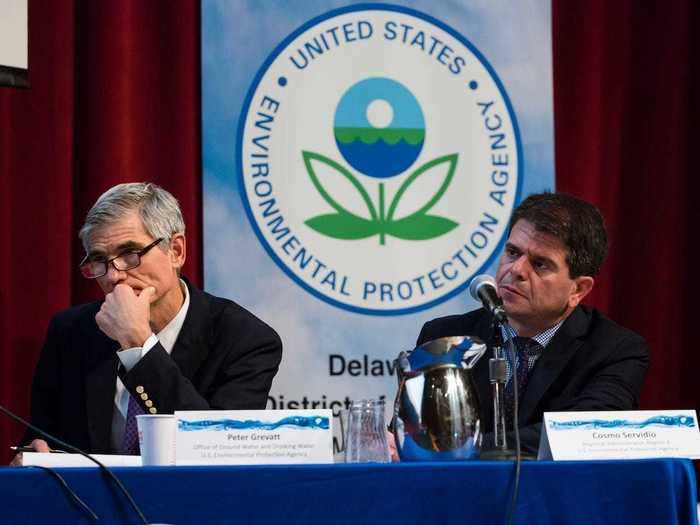6 products in your home that may contain toxic 'forever chemicals'
Andrea Michelson

- PFAS are known as "forever chemicals" because they linger in humans and the environment.
- They can increase the risks of some cancers, low birth weight, and problems with the immune system.
- Nonstick cookware, stain-resistant sprays, and water repellent gear might contain PFAS.
A couple years ago, I had a run-in with potentially toxic cookware.

I was staying in an Airbnb in Washington, DC, with two friends from college. We didn't buy many kitchen supplies for our three-month stay, so on the rare occasions when we used the oven, we would make do with a nonstick pot meant for the stove.
One night, we used the pot to bake some tater tots at around 425°F. After about 15 minutes, we noticed an overwhelming chemical smell. Panic ensued as we tried to air out any potentially dangerous fumes.
A Google search revealed we were right to worry.
Overheating nonstick cookware at 570°F or higher leads to the release of harmful chemicals that can cause an illness called "Teflon flu," or polymer fume fever. Luckily, we didn't use such a high temperature, and the smell soon abated.
That's when I learned about PFAS exposure.

PFAS (per- and polyfluoroalkyl substances) are also known as "forever chemicals" because they're slow to break down in the environment and the body.
Long-term exposure to PFAS can lead to health problems, such as increased risk of some cancers, low birth weight, and problems with the thyroid and immune system.
Despite their potentially toxic impact, the chemicals are found in several common household items.
Nonstick cookware

Until 2013, Teflon products were made with PFOA, a type of PFAS that has been linked to health harms such as increased risk of some cancers, low birth weight, and reduced immune system function.
Most nonstick products made today are PFOA-free, but that doesn't mean they're untainted by the more than 4,700 new PFAS created to take its place.
Some of those new PFAS, also known as "short-chain PFAS," have already been linked to similar health harms in early research.
Stain-resistant furniture and carpets

Stain-resistant coatings used on carpets, upholstery, and other fabrics may be laden with PFAS, according to the CDC.
If you have infants or toddlers at home, it's especially important to consider the chemicals that could be in your carpet. Rugs are a major source of PFAS exposure for little ones who are likely to put their hands in their mouths after touching the material.
Adults may end up unknowingly ingesting PFAS in their homes as well. The chemicals in your furniture and carpets can contaminate the "house dust" you breathe in over time, Anna Reade, staff scientist with the National Resources Defense Council, said at the EWG PFAS Conference.
Water-repellent gear

Your raincoat may also contain some long-lasting chemicals.
While wearing water-repellent clothing isn't a major driver of PFAS exposure for humans, the process of manufacturing those materials is harmful to the environment.
Luckily, several big brands have made strides towards eco-friendly alternatives. Gore-Tex (which is basically the Teflon of rain gear) has committed to completely eliminating PFCs of Environmental Concern from its manufacturing chain by 2023.
The Green Science Policy Institute has compiled a list of other brands that make PFAS-free rain gear and other essentials.
Grease-resistant takeout containers

Food packaging used at Burger King, McDonald's, and Wendy's all were revealed to have indicators of PFAS in a report published by Safer Chemicals, Healthy Families last year.
The chemicals are used to make paper or cardboard containers resistant to grease or oil.
But it's not just stereotypically unhealthy fast food that's affected. The so-called "environmentally friendly" bowls used at Cava, Freshii, and Sweetgreen also tested extremely high for PFAS, according to the report.
Cosmetics, especially waterproof or long-lasting products

More than three-quarters of waterproof mascara, nearly two-thirds of foundations and liquid lipsticks, and more than half of eye and lip products had indicators of PFAS in a recent study.
Many of those products were marketed as waterproof or long-lasting, which is the type of effect PFAS is often used to achieve, according to the study authors.
Of the 231 makeup products tested, more than half had high fluorine levels, an indicator that suggests the presence of PFAS. Most of the products did not disclose PFAS on their labels, so consumers may be unaware of the dangerous chemicals in their cosmetics.
Drinking water

PFAS exposures from household products are quite low compared to exposures to contaminated drinking water, according to the CDC.
Communities located near military bases, such as Newburgh, New York, often find their water supplies contaminated with PFAS. The pollution can also affect local fish populations and the people who eat them.
Those populations have PFAS levels in their blood up to four times higher than the national average, Scott Faber, EWG senior vice president of government affairs, said at the EWG PFAS conference.
"That's just wrong," Faber said. "None of us consented to be contaminated with toxic forever chemicals, and we're all paying the price in the form of higher water bills and higher health care costs."
READ MORE ARTICLES ON
Popular Right Now
Popular Keywords
Advertisement